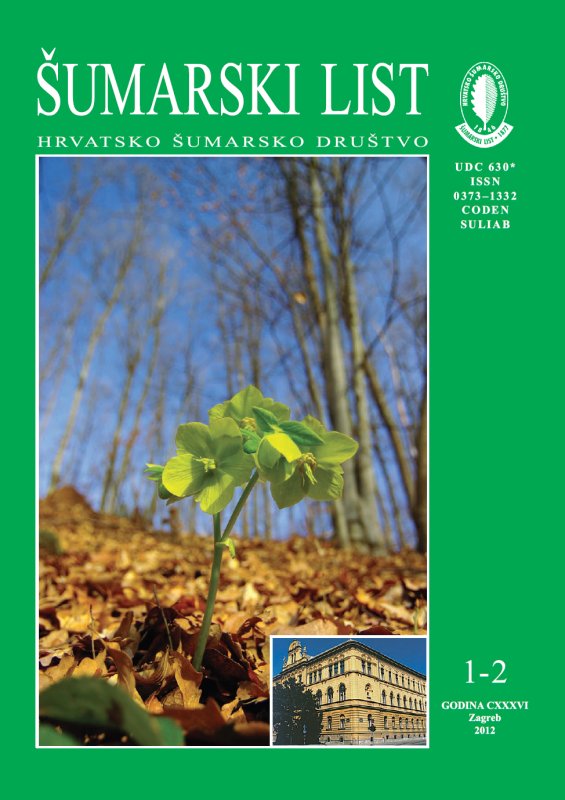
broj: 1-2/2012
pdf (10,1 MB) |
|
||||||||||||||
| RIJEČ UREDNIŠTVA | ||
| Uredništvo | ||
| DEPARTURE OFA MAN WHOSE EDITORIALSHIP LEFT A PERMANENT AND UNERASABLE TRACE IN OUR JOURNAL pdf HR EN | 1 | |
| IZVORNI ZNANSTVENI ČLANCI | ||
| Škvorc,Ž., K.Sever, J.Franjić, D.Krstonošić, M.Poljak | UDK 630* 114.2 + 561 - 562 (Quercus roburL.) (001) | |
| Photosyntesis Intensity andVegetative Growth of Pedunculate Oak (Quercus roburL.) in Common-Garden Experiment pdf HR EN | 7 | |
| Diminić,D., N.Potočić, I.Seletković | UDK 630* 232 + 443 (Pinus nigra Arnold) (001) | |
| The Role of Site in Predisposition ofAustrian Pine (Pinus nigraArnold) to Pathogenic FungusSphaeropsis sapinea(Fr.) Dyko et Sutton in Istria (Croatia) pdf HR EN | 19 | |
| Summary: Austrian pine (Pinus nigra Arnold) was commonly planted during the last century in Croatia. Afforestation took place on various sites to prevent land from erosion and, or to restore forest vegetation, mainly in karst areas. Since 1992 the study on health status of Austrian pine plantations in Croatia revealed significant dieback symptoms in some areas as the consequence ofSphaeropsis sapineaoccurrence. Research carried out in November 2001 found the fungus presence with different impact to P. nigrain Istria, healthy sites and also ones with various disease symptoms were observed (Figure 1, Table 1). In plantations which revealed good health statusS. sapineawas found only on cones, but in plantations with dieback symptoms its presence was found in needles, shoots and branches, causing in some cases dieback of trees. According to dieback symptoms observed, research localities were categorised in four health categories as shown in Figure 1. It was revealed that along the drought (Figures 19 and 20, an example for period 1961–1990 vs. 1999), the site conditions also played an important role in pines’ predisposition to fungus attack during last years. This conclusion was supported by analyses of nutrition status in pines and site conditions (soil sub-types, soil types and depth, site rockiness, exposition and inclination, Table 1). Analyses of nutrition status obtained clear difference among sites comparing the nitrogen (N) and potassium (K) concentrations in pine needles (Figures 6–11). In sites with lower N/K ratio the disease symptoms were not observed, but in sites with increased N/K ratio the dieback symptoms were revealed, following nitrogen and potassium relation in general (Figures 12 and 13). According to Brown (1999) fertilization only by nitrogen can increase the susceptibility of broadleaved trees to pathogenic organisms due to the influence of nitrogen on growth of aboveground plant biomass, and imbalance of above- and belowground plant parts biomass can lead to the increased susceptibility of trees to water stress. Higher nitrogen concentartions as pines’ predisposition to S. sapinea were confirmed by De Kam et al. (1991), Van Dijk et al. (1992) and Stanosz et al. (2004). Opposite to nitrogen, potassium play important role in plant resistance to drought and pathogenic organisms (Bergmann 1992, Marschner 1995). Inoculation experiment in Austrian pine seedlings confirmed the S. sapinea pathogenicity and also the same capability of isolates obtained from healthy needles (VIPAVA, IMI 368260) and ones with symptoms (DP 04-1 and DP 06-3, described in Diminić et al. 2004) to cause bark necrosis. Previous fertilization with ammonium sulphate caused increased seedlings growth according to treatments: 0, 20, 40 and 80 g/m2, and also increased length of bark necrosis in inoculated pines (Tables 2 and 3, Figures 14–18), which supported the nitrogen role in disease development. According to up-to-day worldwide knowledge and results of our research, it can be concluded thatS. sapineacan live (latent phase) in healthy looking pines in Istria. And, in drought periods it can turn to serious pathogen, causing dieback in predisposed trees. It this circumstances, site play an important role in pines’ resistance to disease, indirectly influencing appearance (or not) of various dieback symptoms. Key words: dieback; drought; health status; Pinus nigra; plantations; site conditions; Sphaeropsis sapinea | ||
| Andrašev,S., M.Bobinac, S.Rončević, M.Vučković, B.Stajić, G.Janjatović, Z.Obućina | UDK 630* 232.5 + 242 (001) | |
| Effects of Thinning in a Plantation of Poplar Clone I-214 withWide Spacing pdf HR EN | 37 | |
| PRETHODNO PRIOPĆENJE | ||
| Matošević, Dinka | UDK 630* 453 (Aproceros leucopoda) | |
| First record of Elm Sawfly (Aproceros leucopoda), new Invasive Species in Croatia pdf HR EN | 57 | |
| STRUČNI ČLANCI | ||
| Matović,B., M.Koprivica, Z.Maunaga | UDK 630* 527 + 521 | |
| Application of Generalized Taper Model of Norway Spruce Tree in Forestry Practice pdf HR EN | 63 | |


